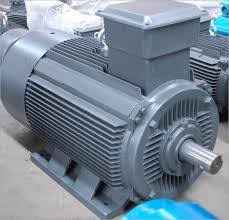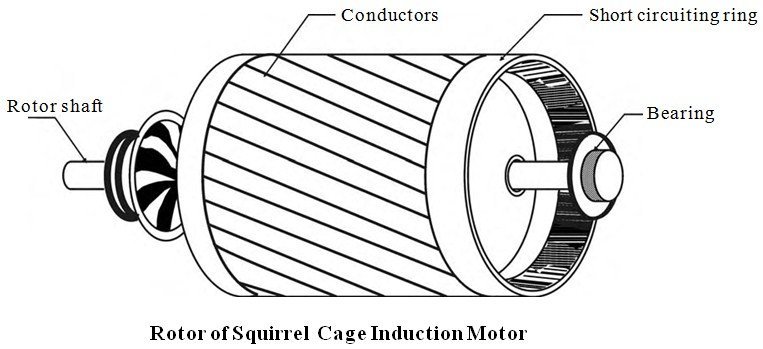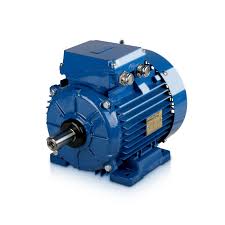
A 3 phase induction motor has two types based on the rotor construction, named as: Squirrel Cage Induction Motor and Wound Rotor Induction Motor. Former is cheaper and broadly used as it requires less maintenance than later one. Firstly, I am going to tell you about the structure of squirrel cage induction motor. Afterwards I will cover the working principle and features of Squirrel Cage Induction Motor. In the last sections, I will share some advantages and uses. In simple words, the type of 3 phase induction motor which uses a squirrel cage rotor is called squirrel cage induction motor.
Construction of Squirrel Cage Induction Motor
All induction motors have a rotor and a stator. Basically, it is the construction of rotor which makes Squirrel Cage Induction Motor different from Wound Type Induction Motor. Stator is same in both types of motors. Let’s first talk about stator of Squirrel Cage Induction Motor:
Stator of Squirrel Cage Induction Motor
- Stator is that component of motor which is stationary.
- It is the outer most frame in which rotor is placed.
- It has grooves on internal circumference to carry electric circuitry. This circuitry is excited by 3 phase supply.
- The 3 phase winding circuit is placed on the slots. These winding are 120 degrees apart connected as star or delta configuration.
- Now let’s move towards the construction of rotor.
Rotor of Squirrel Cage Induction Motor
- Rotor is the rotating part of a motor. It contains a cylindrical core.
- The rotor core is made in lamination to reduce eddy currents.

- Squirrel cage type rotor consists of bars of copper that we call conductors.
- The copper bars or conductors are longer than the rotor and are fixed in grooves of rotor core.
- These extended conductors are short circuited with each other by means of copper rings on each sides.
- Also rotor is sometimes provides with fans on each side for cooling purposes.
- This type of construction of bars and end rings is similar to a squirrel cage on which it is named.
- That was all about rotor construction. Other than rotor and stator, a motor has also other parts to support and protect the assembly.
- Introduction to Induction Motor.
- Single Phase Induction Motor.
- 3 Phase Induction Motor.
- Introduction to Synchronous Motor.
Working of a Squirrel Cage Induction Motor
In this section, I will share the working of a squirrel cage induction motor with you guys.
- When the winding of stator are given a 3 phase AC supply, a current will start flowing through it.
- This 3 phase AC will give rise to a rotating magnetic field in the rotor.
- The speed of rotation of this magnetic field can be found from the frequency of AC supply and number of poles.
- This speed is the synchronous speed of motor.
- The rotating magnetic field of stator will induce voltage in rotor because its flux lines cut through the rotor. This induced voltage will induce current in rotor winding and another magnetic field will be generated which is rotor’s magnetic field.

Key Features
Now I am mentioning some important features of a squirrel cage induction motor. I will talk about speed, starting current, direction of rotation, slip and power factor. First on the list is speed.
Speed
A squirrel cage induction motor generally operates at a constant speed. This speed is synchronous speed.
Starting Current
Such motors require high starting currents. Which may result in fluctuations in voltage.
Direction of Rotation
The direction of rotation of these motors can be reversed if you interchange two power lines out of three.
Slip
As for other induction motors, the slip is defined as the difference in speed of rotating magnetic field of stator and rotating speed of rotor. The speed of rotation of magnetic field is called synchronous speed. Slip is expressed as a ratio with synchronous speed or in percentage.
Power Factor
Power factor is the ratio of actual power to apparent power. It is expressed in percentage. The power factor is low when motor is running at no load and it is high when motor is operating at full load.
Advantages
In this part, I will tell you guys some of the advantages of squirrel cage induction motor.
- Squirrel cage induction motors are:
- Cheap
- Robust
- Rugged
- Require less maintenance
- Due to cage structure of rotor, they require less material. So copper losses decrease.
- Due to absence of brushes, the chances of spark are reduced.
- These motors are provided with fans, so less heat is generated.
Now I am moving towards the last segment of my article, where I will tell you some of the uses of squirrel cage induction motors.
Uses
This type of motor finds its uses in industries because of their cost. They are extensively used in industrial applications instead of wound type induction motor. They are used in applications where low starting torque is needed. Such motors may also be used as generators.



